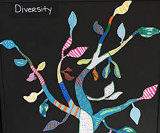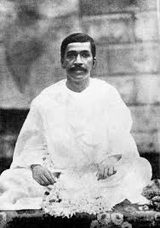Yoga
The power of harmony in times of crisis
Abstract
Contemporary psychological, social and ecological crises have their root in the crisis of consciousness. The ordinary consciousness is a consciousness of a narrow ego that brings chaos and discord, obscurity and disharmony. The new consciousness is being born to create a new world. It is a consciousness of love and oneness, unity in diversity, harmony and delight. Harmony will be the law of the new world. The Force of Harmony manifest in all aspects of being and life is a powerful response to the crises of our times. The article also talks about how to receive this Force.
The times of crisis
We are living in times of great chaos and crisis. Socially, we are more divided than ever. There is rising inequality. The richest one percent of the world’s population owns half its wealth. The top 1% richest individuals in the world have captured twice as much growth in financial wealth as the bottom 50% of individuals since 1980 (1). The division in income is only one facet; there is divisiveness over caste, gender, religion, race and nation. Its violent form today is more visible than ever, as people are beginning to question political boundaries and media is becoming more decentralised and accessible.
As society grapples with the issue of gross inequalities, the planet is struggling with over-exploitation driven by spiralling human consumption. Over the past 50 years our ecological footprint — one measure of our consumption of natural resources —has increased by about 190% (2). 60% of animals have been annihilated since 1970. The numbers are never-ending. One just has to look around to see the suffering that humans have inflicted upon the planet.
In the modern ego-centred economy, the sacred body of Mother Earth has been reduced to toys and coins of the marketplace. The Western mindset of accumulation and consumption as parameters of growth has become the global standard. The spiritual man of the East, who has been an ascetic for a long time, is only waking up now not to integrate Spirit and Matter, but to honour the body and the manifestation.
The social crisis mirrors the psychological crisis. The UK has a Minister of Loneliness (3). In the US, depression is on an unprecedented rise, with the diagnosis of depression rising by 33% from 2013 to 2016 (4,5). In India, as much as 36% of the population has suffered from major depression at some point in their lives (6). Globally today, suicide is the second leading cause of death among 15-29 year- olds.
The list of shocking numbers goes on. The factors speculated for these are many: lack of community, addiction to technology, an old and factory-like education system, a mechanical job-life, a hopelessness in times of seemingly unconquerable crisis, these are only a few. The social crisis feeds into the psychological crisis; the psychological crisis into the social. But is there a greater crisis behind the apparent social and psychological crises of our times?
Behind the psychological and the social is the spiritual. Because of its long association with religion, some people tend to think of spiritual as something to do with a God sitting up there, morally dictating what to do and what not to do. But that is not what we mean here. What we mean here is that there is an evolution of consciousness behind the psychological, social and ecological crisis. There is stagnation in this progress at the level of the mind, which refuses to follow or acknowledge the evolution of consciousness that transcends the present mind-principle.
Consciousness is at the base of all that is manifest. It is the source of all creation. Predominantly, the ordinary consciousness of human beings is egoistic and mental. It is yet to go beyond the mind, establish within itself consciousness of unity and harmony. As long as human beings as a species continue to operate from a separated consciousness, there will be collision, conflict, crisis and chaos in one way or the other. It is only when the mode of operation shifts from a consciousness divided by ignorance and a separatist egoism (7), to a universal consciousness that a true resolution of crisis can come about. It is through changing the essence that the fractals can come out differently.
Harmony in times of crisis
In these times of crisis and chaos to even talk about harmony would feel like a distant dream to many. To many others it will be an unimportant aim in comparison to what are perceived as more urgent and pressing issues of our times. It is only when one begins to see that we are not only a part of the times of crisis but also of a time of a great evolution, of a great possibility of manifestation of new consciousnessin the history of Earth, of a new Earth, that one begins to see and sense the value of aspiring for harmony.
In fact, focusing on the power of harmony may actually give us clues to responding to the issues of the 21st Century. Sri Aurobindo in The Life Divine writes that, “… all problems of existence are essentially problems of harmony (8).” The social crisis represents an unresolved attempt at finding harmony between different cultures and peoples of the world. The ecological crisis represents an unsolved discord between human needs and the planet’s balance. The psychological crisis represents an ignorance of a deeper love and oneness that brings harmony and unity in life.
What is harmony?
Sri Aurobindo defines harmony as the natural rule of the spirit, the inherent law and spontaneous consequence of unity in multiplicity, of unity in diversity, of a various manifestation of oneness (9). In other words, there is a point of magic, where all comes together, where there is unity but also a living diversity, where one does not have to mentally force fit things but can simply just flow as integral totality. This is the power of harmony. Harmony is the force of love and oneness poured in action, dynamically expressed as unity in diversity, in a multiple oneness.
The following two sections talks about the principle of harmony, giving geometrical and living sense of what harmony is.

Point of balance
Principle of harmony
In the lower nature, the dualities — attraction and repulsion, capacity and incapacity, liking and disliking, pleasure and pain, joy and sorrow, acceptance and repugnance — are the inevitable effect of the play of rajas (principle of movement) and tamas (principle of inertia). The balance between these two opposite extremes, of inertia and restless movement brings a certain light, harmony and balance (sattwa). But sattwa itself does not give the highest or the integral perfection; it has always a quality of the limited nature; sattvic knowledge is the light of a limited mentality (10). True harmony requires a transcendence of dualities, into a totality where each unique aspect is in its right place; it is no longer ‘this versus that’. There is a symphony, a rhythm, a wholeness with non-contradicting parts, making the flower of life come alive. It is this that is pictorially depicted in the diagram shown.
To illustrate the principle of harmony, let us take the ecological crisis as an example. In the ecological crisis, often the human is pitted against Nature. The two are seen as separate. Many argue that the earth has been made for humans, thus the needs of human beings must get a priority. Others argue that since humanity has violated Nature for years altogether, now one must respect the earth and not care about stupid human beings. Many others argue for a balance between humans and Nature, that we take into account the needs of both humans and Nature, without a like-dislike towards any. The law of harmony demands us to go a step further. It sees humans and Nature as one. Their needs are not separate. Nature and humans both need to thrive for manifesting the Divine on earth.
Characteristics of harmony
A critical aspect of harmony is totality. Wherever there is harmony, there is completeness, totality, wholeness. The Mother affirms, “Each thing in its place, in harmony with all the rest, then one can begin to understand and to live (11).” Even all that is not harmonious and out of place or all that involves pain and suffering has an evolutionary role and place in this totality. Nothing is discarded. For instance, from the view of harmony, pain and suffering are not seen as bad, but as tools of Nature at perfecting the human instrument.
Secondly, harmony has a centre that gives equilibrium and balance. Harmony comes through equilibrium between different parts, a balance that gives the perfect hierarchy.1 In an individual, at the centre is the psychic. The psychicbeing is the evolving soul in nature. It is this part which forms a conscious and living relationship with the Divine and has the potential of harmonising different parts of the being.
Thirdly, harmony consists of multiplicity. It involves not eliminating anything but putting each thing in its place in total harmony with the rest.
Fourthly, harmony is the dynamic form of Bliss or Ānanda.
This simple childlike scheme of harmony involving totality, centre, multiplicity and joy is dynamic and progressive.
Mental harmony
Using the above characteristics of harmony, we can make mental models that respect principles such as multiplicity and diversity over a mechanical uniformity and implement it in our lives. For instance, we can consciously be more inclusive of diversity in our communities and work or make a routine for ourselves that looks after the development of our body, emotions, intellect and soul; not just any one aspect. These will surely help in bringing harmony.
But mind, in its ordinary existence, cannot truly contain the complexity of true harmony that carries the largest possibility with the smallest little detail. Imposition of the mental will more often than not produces standardisation and fixity, which is contrary to the Forces of Nature. Nature finds joy in diversity, variety and idiosyncrasies.
Further, these characteristics can help us understand the movement of harmony metaphysically, but one may ask, is there a part in our psyche that can carry the entire spectrum from infinity to minute detail seamlessly, embodied moment to moment into one’s actions? According to Sri Aurobindo, there is. The next sections talk about this.
The Force of harmony
Sri Aurobindo talks about harmony as one of the four fundamental Powers of the Divine: Wisdom, Power, Harmony and Perfection in Work. He describes the Conscious Force of Harmony as Mahalakshmi. The following are a few of his descriptions of Mahalakshmi (12):
“Above them [Wisdom and Force] is the miracle of eternal beauty, an unseizable secret of divine harmonies, the compelling magic of an irresistible universal charm and attraction that draws and holds things and forces and beings together and obliges them to meet and unite that a hidden Ananda may play from behind the veil and make of them its rhythms and its figures. This is the power of Mahalakshmi and there is no aspect of the Divine Shakti more attractive to the heart of embodied beings....
“Harmony and beauty of the mind and soul, harmony and beauty of the thoughts and feelings, harmony and beauty in every outward act and movement, harmony and beauty of the life and surroundings, this is the demand of Mahalakshmi .... Where love and beauty are not or are reluctant to be born, she does not come.... For it is through love and beauty that she lays on men the yoke of the Divine....
Admitted to the heart she lifts wisdom to pinnacles of wonder and reveals to it the mystic secrets of the ecstasy that surpasses all knowledge, meets devotion with the passionate attraction of the Divine, teaches to strength and force the rhythm that keeps the might of their acts harmonious and in measure and casts on perfection the charm that makes it endure forever.”
Now the question arises how does one prepare oneself to receive the force of harmony that brings everything together in a beautiful rhythm, with a joy of progress? The following is a summary of literature reviewed from the Collected Works of the Mother on harmony.
Realising Harmony
The manifestation of harmony among a few people could carve a way towards a shift in collective consciousness. On the other hand, people who are interested in concretely realising Divine Consciousness must work for goals such as creating a world union and a fairer world. In both cases, inner transformation is fundamental to realising harmony.
For inner transformation, observing oneself and being aware, particularly of the parts where harmony does not exist, i.e. the parts which are in contradiction with the inner aspiration is the first step (13). Once one has awareness, the following powers of the spirit help in receiving the Force of Harmony:
• Faith in the power of the Divine to transform and harmonise,
• Sincerity of the intent,
• Perseverance, even amidst the resistances and inertia that cause disharmony,
• Openness to the rhythm of life,
• Finding the delight and a liberated self within oneself,
• A constant inner purification,
• Aspiration for perfection,
• Surrender to the Divine.
These are only a few inner qualities and movements that help in opening up to receive the Force of Harmony. Besides, the following are a few tools proposed by the Mother for bringing harmony into our instruments of the mind, body and vital.
• Educating the mind by positive thinking, which would involve creating noble thoughts and imaginations;
• Educating the vital forces to harmonise the psychological health. For instance, using art, such as poetry, to express particularly when one feels low, in order to uplift energies. Poetry need not only be about skill and talent. It can be a powerful tool for transformation of nature. Another example for bringing harmony in the vital is to refuse pleasure and pursue Delight;
• Bringing harmony and balance in the movements and activities of the body (for, it naturally likes equilibrium).
Good health, wisdom, good will, thoughtful actions are all signs of harmony and can be practised when the disorder/suffering of life is overarching.
Harmony within and with others
In particular, to harmonise different parts of oneself, She advises to study, reflect, intellectually exercise, and change oneself. And, to harmonise relationships with others, bringing balance between receptivity and expenditure and attuning the minds are central. In dealing with particularly difficult people, doing what one ought to do with simplicity and sincerity, while being equanimous and calm always helps.
Disharmony to harmony
The lack of harmony comes out of inertia or resistance to the Truth. Even when life’s circumstances are tough, one can always find harmony. On the other hand, we can invite disharmony in our lives even through our good intentions. For instance, a humanitarian often attracts suffering upon himself. It can often cause illness.
To avoid the catastrophes of disharmonies and to increase harmony, the Force of Harmony must be invoked and space must be created for its intervention. Silencing the mind and calming the heart creates space for the Harmonious Force to live and express. Creation of this space involves movement from the ego, which likes reacting to everything in the environment and is focused on individual determinations, towards the true person, who naturally points in the direction of the soul and thus, acts in harmony with it.
Conclusion
The social, ecological, and psychological crisis of the modern day reflect a lack of harmony on the inside. There is chaos in the world because there is chaos inside. The more one awakens, the more the lines between ‘the problem is in the society’ and ‘the problem is in the self’ distinction fade away. What one sees is that the two are one and both express a consciousness ignorant, sleeping, dwindling between rajas and tamas. The only way out is to bring unity and harmony in oneself, which with the practice of work and action, naturally extends into joyful harmony in all aspects of life.
References
1. Alvaredo F, Chancel L, Piketty T, Saez E, Zucman G. World inequality report 2018. World Inequality Lab; 2018.
2. Living Planet Report — 2018: Aiming Higher. Switzerland: WWF.
3. Pimlott N. The Ministry of Loneliness [Online] PubMed Central (PMC) Available from: https://www.ncbi.nlm.nih.gov/pmc/articles/PMC5851382/ [Accessed 8th November 2018].
4. Blue Cross Blue Shield. The Health of America [Online] Available from: https://www.bcbs.com/the-health-of-america [Accessed 8th November 2018].
5. Fox M. Major depression on the rise among everyone. NBC News [Online]. Available from: https://www.nbcnews.com/health/health-news/major-depression-rise-among-everyone-new-data-shows-n873146 [Accessed 8th November 2018].
6. World Health Organisation. Depression in India 2018 [Online]. Available from: http://www.searo.who.int/india/depression_in_india.pdf [Accessed 8th November 2018].
7. Sri Aurobindo. Birth Centenary Library, Volume 18. Pondicherry: Sri Aurobindo Ashram Trust; 1970, p. 168
8. Ibid., p. 2.
9. Sri Aurobindo. SABCL, Volume 19; 1970, p. 1064.
10. Sri Aurobindo. SABCL, Volume 21; 1970, p. 659-60.
11. The Mother. Collected Works of the Mother, Volume 9. Cent. ed. Pondichery: Sri Aurobindo Ashram Trust; 1977, p. 257.
12. Sri Aurobindo. SABCL, Volume 25; 1972, pp. 30-3.
13. The Mother. Collected Works of the Mother, Volume 7. Cent. ed. Pondicherry: Sri Aurobindo Ashram Trust; 1979. pp. 1-2.
1The perfect hierarchy is a spiritual hierarchy, wherein parts fall around a centre, without a sense of superiority and inferiority, but rather according to their svabhaava (true nature) and svadharma (individualised purpose).
Divyanshi Chugh is a core member of the Auroville Campus Initiative at SAIIER, Department of Further Learning in Auroville.
Share with us (Comments,contributions,opinions)
When reproducing this feature, please credit NAMAH,and give the byline. Please send us cuttings.








